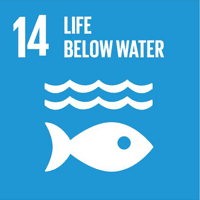14
EKOSISTEM
LAUT
Melestarikan dan Memanfaatkan Secara Berkelanjutan Sumber Daya Kelautan dan Samudera untuk Pembangunan Berkelanjutan
Life Below Water

Universitas Nahdlatul Ulama Surabaya (Unusa) demonstrates a deep commitment to environmental stewardship by actively supporting aquatic ecosystems, implementing water-sensitive waste disposal practices, and working to maintain local ecosystems. Through a series of well-structured initiatives and collaborations, Unusa aligns itself with global sustainable development goals (SDGs), particularly those focused on protecting life below water and on land. The university’s integrated approach to environmental sustainability reflects an understanding of the interconnectedness between healthy ecosystems and resilient communities.
Unusa efforts in supporting aquatic ecosystems center on safeguarding water quality and preventing pollution through sustainable campus policies and community partnerships. Initiatives such as the construction of reservoirs on the UII Integrated Campus serve to improve water conservation and regulate water flow, protecting downstream aquatic ecosystems from pollution and erosion. Collaborations with local government bodies, such as the Serayu Opak River Area Main Station, further underscore UII’s role in watershed management and sustainable water resource planning.
In its waste management practices, UII prioritizes water-sensitive solutions aimed at minimizing environmental impact. The university has established preliminary guidelines for waste disposal and water quality standards to ensure that any water discharged from campus activities meets quality benchmarks that protect local wildlife and human health. Additionally, Unusa has introduced preliminary policies aimed at reducing plastic waste on campus, recognizing its impact on both terrestrial and aquatic ecosystems. These foundational steps support sustainable waste disposal practices and set the stage for more comprehensive water management strategies that contribute to healthy ecosystems.
Beyond campus boundaries, Unusa is dedicated to maintaining local ecosystems through conservation programs and policies. The university’s commitment to biodiversity is evident in its efforts to incorporate local species into campus planning processes, minimize the impact of invasive species, and foster collaboration with local communities for ecosystem preservation. Tree-planting initiatives, for example, help maintain shared green spaces, while research initiatives provide valuable insights into conserving and restoring threatened habitats.
Through its proactive approach to supporting aquatic and terrestrial ecosystems, UII exemplifies how academic institutions can serve as leaders in sustainability. By addressing the environmental challenges that affect both water and land, UII contributes to a resilient local ecosystem and a more sustainable future for all.
Unusa Efforts in Supporting Aquatic Ecosystems through Education
- Educational Programs on Freshwater Ecosystems
- Community Outreach on Sustainable Fisheries and Aquaculture
- Awareness Programs on Overfishing and Sustainable Fishing Practices
Unusa provides significant educational and research support on freshwater ecosystem management through the efforts of its Civil and Environmental Engineering departments. The Civil Engineering department actively researches flood and drought prevention methods, while the Environmental Engineering department operates a dedicated water quality laboratory. Together, these programs equip students and local communities with knowledge on water conservation, management, and sustainable irrigation practices. This aligns with SDG 14 by promoting sustainable water resource usage.
Unusa extends its expertise in environmental engineering to offer insights into sustainable water practices that benefit both agriculture and, indirectly, aquaculture sectors. By working with local communities, the university provides knowledge on sustainable water use that supports ecosystem health and potentially benefits sustainable fisheries and aquaculture practices.
While Unusa primary focus within SDG 14 is on freshwater management, there is potential for expanding educational outreach on issues related to overfishing and responsible fishing practices. Unusa research into ecosystem resilience and water quality can serve as a foundation for future programs addressing broader aspects of aquatic conservation, such as sustainable fisheries and awareness around harmful fishing practices.
Unusa Actions in Supporting Aquatic Ecosystems Conservation
- Events Promoting Aquatic Conservation
- Sustainable Sourcing of Aquatic Foods
- Ecosystem Conservation and Biodiversity Protection
- Research and Technology for Sustainable Aquatic Industries
Unusa is actively involved in conservation-focused events that raise awareness of sustainable practices for oceans, seas, and freshwater ecosystems. For example, the Faculty of Law has organized seminars focused on empowering coastal communities, addressing challenges in marine governance, and promoting resilience in coastal ecosystems. Additionally, Unusa students participate in discussions on marine conservation topics, fostering a culture of responsible ocean stewardship in line with SDG 14.
Although Unusa has not yet implemented specific regulations for sourcing from aquatic ecosystems, its halal food policyunderlines sustainable and ethical sourcing. The Halalan Thoyyiban Research and Education (HTREND) center further strengthens these efforts by advocating for environmentally responsible sourcing of all food products, including aquatic ones. This approach contributes indirectly to the conservation of aquatic ecosystems by emphasizing ethical supply chain practices, which UII could expand through targeted policies on sustainable harvesting of aquatic resources.
Unusa is progressively embedding policies focused on aquatic ecosystem management within its broader quality assurance framework, with initiatives aimed at protecting biodiversity and supporting sustainable practices. This approach aligns with Unusa commitment to long-term environmental stewardship, especially for threatened ecosystems. In collaboration with various faculties, Unusa is developing research and outreach programs aimed at sustaining both aquatic and terrestrial biodiversity, thus supporting SDG 14’s objectives.
While direct engagement with the marine industry is currently limited, Unusa is exploring ways to extend its impact in sustainable technology. Through cross-departmental collaborations, Unusa seeks to innovate in areas that could support industries in minimizing environmental damage. As Unusa continues to expand its environmental research, there is potential for increased involvement in technology solutions for aquatic conservation.
Unusa Initiatives in Water-Sensitive Waste Disposal
Unusa has implemented strict water quality guidelines to control its water discharges, ensuring they meet standards that protect both the surrounding ecosystems and public health. These procedures include monitoring water quality in campus waste and runoff to prevent contaminants from affecting nearby aquatic environments, aligning with SDG 14’s commitment to ecosystem preservation.
Unusa actively pursues a plastic waste reduction strategy, including initiatives like the nationally recognized Project B led by Dr. Hijrah. This project promotes recycling, the use of alternative materials, and circular economy practices to minimize plastic waste. Project B’s impact extends to broader environmental goals by reducing plastic pollution, which is essential for the protection of marine ecosystems under SDG 14.
In its approach to waste management, Unusa emphasizes preventing marine pollution originating from land-based activities. By reducing plastic waste and fostering sustainable waste management practices on campus, Unusa supports initiatives aimed at protecting oceans from harmful pollution sources. Although directly focused on land, these policies benefit marine ecosystems by minimizing runoff pollution, reinforcing Unusa contribution to SDG 14.
Unusa Initiatives for Maintaining Local Aquatic Ecosystems
- Minimizing Environmental Impact on Aquatic Ecosystems
- Collaborative Monitoring and Research
- Community Aquatic Stewardship
- Community Partnerships for Ecosystem Maintenance
- Watershed Management Strategy
Unusa integrates sustainable building practices within its green campus master plan by following LEED-aligned policies. While these initiatives mainly aim to minimize the environmental impact on land, they also reduce chemical runoff and physical disruption to nearby aquatic ecosystems, indirectly supporting SDG 14 by promoting clean water flow into surrounding habitats.
Unusa actively partners with local communities to monitor and manage aquatic ecosystem health. Through collaborative research efforts at various university research centers, Unusa engages in projects focused on assessing ecosystem health and addressing water quality challenges, aligning with SDG 14’s goal of sustaining healthy aquatic ecosystems through science-based monitoring.
By supporting community programs and partnerships, Unusa promotes good aquatic stewardship practices. Research and outreach activities encourage responsible ecosystem management among local stakeholders, enhancing UII’s impact on sustainable water usage and conservation practices.
Unusa emphasizes community collaboration in its approach to environmental sustainability. Through joint projects and educational initiatives, the university works closely with local communities to implement sustainable practices in watershed areas. This cooperative model aligns with SDG 14 by fostering community engagement in the conservation of shared aquatic resources.
Unusa has demonstrated its dedication to watershed management by building two reservoirs in partnership with the Serayu Opak River Area Main Station. These reservoirs, located within the Unusa Integrated Campus, help to regulate water resources and support local biodiversity. This strategy contributes to the conservation of the watershed, ensuring a balanced ecosystem for diverse aquatic species, which aligns with the goals of SDG 14.
